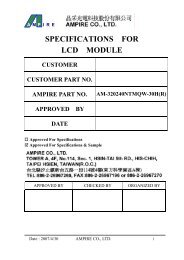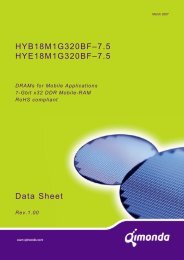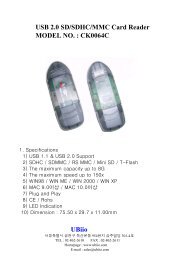Create successful ePaper yourself
Turn your PDF publications into a flip-book with our unique Google optimized e-Paper software.
Internet Data Sheet<br />
7.4 ODT AC Electrical Characteristics<br />
This chapter describes the ODT AC electrical characteristics.<br />
HY[B/I]18T256[40/80/16]0B[C/F](L)<br />
256-Mbit Double-Data-Rate-Two SDRAM<br />
TABLE 59<br />
ODT AC Characteristics and Operating Conditions for DDR2-533 and DDR2-400<br />
Symbol Parameter / Condition Values Unit Note<br />
Min.<br />
Max.<br />
t AOND ODT turn-on delay 2 2 t CK<br />
t AON ODT turn-on t AC.MIN t AC.MAX + 1 ns ns<br />
1)<br />
t AONPD ODT turn-on (Power-Down Modes) t AC.MIN + 2 ns 2 t CK + t AC.MAX + 1 ns ns<br />
t AOFD ODT turn-off delay 2.5 2.5 t CK<br />
t AOF ODT turn-off t AC.MIN t AC.MAX + 0.6 ns ns<br />
t AOFPD ODT turn-off (Power-Down Modes) t AC.MIN + 2 ns 2.5 t CK + t AC.MAX + 1 ns ns<br />
2)<br />
t ANPD ODT to Power Down Mode Entry Latency 3 — t CK<br />
t AXPD ODT Power Down Exit Latency 8 — t CK<br />
1) ODT turn on time min. is when the device leaves high impedance and ODT resistance begins to turn on. ODT turn on time max is when<br />
the ODT resistance is fully on. Both are measured from t AOND , which is interpreted differently per speed bin. For DDR2-400/533, t AOND is<br />
10 ns (= 2 x 5 ns) after the clock edge that registered a first ODT HIGH if t CK = 5 ns.<br />
2) ODT turn off time min. is when the device starts to turn off ODT resistance. ODT turn off time max is when the bus is in high impedance.<br />
Both are measured from t AOFD . Both are measured from t AOFD , which is interpreted differently per speed bin. For DDR2-400/533, t AOFD is<br />
12.5 ns (= 2.5 x 5 ns) after the clock edge that registered a first ODT HIGH if t CK = 5 ns.<br />
TABLE 60<br />
ODT AC Characteristics and Operating Conditions for DDR2-667 and DDR2-800<br />
Symbol Parameter / Condition Values Unit Note<br />
Min.<br />
Max.<br />
t AOND ODT turn-on delay 2 2 n CK<br />
1)<br />
t AON ODT turn-on t AC.MIN t AC.MAX + 0.7 ns ns<br />
t AONPD ODT turn-on (Power-Down Modes) t AC.MIN + 2 ns 2 t CK + t AC.MAX + 1 ns ns<br />
1)<br />
t AOFD ODT turn-off delay 2.5 2.5 n CK<br />
1)<br />
t AOF ODT turn-off t AC.MIN t AC.MAX + 0.6 ns ns<br />
t AOFPD ODT turn-off (Power-Down Modes) t AC.MIN + 2 ns 2.5 t CK + t AC.MAX + 1 ns ns<br />
1)<br />
t ANPD ODT to Power Down Mode Entry Latency 3 — n CK<br />
1)<br />
t AXPD ODT Power Down Exit Latency 8 — n CK<br />
1)<br />
1) New units, “t CK.AVG ” and “n CK ”, are introduced in DDR2-667 and DDR2-800. Unit “t CK.AVG ” represents the actual t CK.AVG of the input clock<br />
under operation. Unit “n CK ” represents one clock cycle of the input clock, counting the actual clock edges. Note that in DDR2-400 and<br />
DDR2-533, “t CK ” is used for both concepts. Example: t XP = 2 [n CK ] means; if Power Down exit is registered at T m , an Active command may<br />
be registered at T m + 2, even if (T m + 2 - T m ) is 2 x t CK.AVG + t ERR.2PER(Min) .<br />
2) ODT turn on time min is when the device leaves high impedance and ODT resistance begins to turn on. ODT turn on time max is when the<br />
ODT resistance is fully on. Both are measured from t AOND , which is interpreted differently per speed bin. For DDR2-667/800, t AOND is 2 clock<br />
cycles after the clock edge that registered a first ODT HIGH counting the actual input clock edges.<br />
3) ODT turn off time min is when the device starts to turn off ODT resistance. ODT turn off time max is when the bus is in high impedance.<br />
Both are measured from t AOFD , which is interpreted differently per speed bin. For DDR2-667/800, if t CK(avg) = 3 ns is assumed, t AOFD is 1.5<br />
ns (= 0.5 x 3 ns) after the second trailing clock edge counting from the clock edge that registered a first ODT LOW and by counting the<br />
actual input clock edges.<br />
1)2)<br />
1)3)<br />
<strong>Rev</strong>. <strong>1.11</strong>, 2007-07 62<br />
11172006-LBIU-F1TN



![Internet Data Sheet HYB18TC256[80/16]0BF Rev. 1.3 - UBiio](https://img.yumpu.com/50510226/1/184x260/internet-data-sheet-hyb18tc25680-160bf-rev-13-ubiio.jpg?quality=85)
![Internet Data Sheet HYS72T[32/64]xxxHP-[3S/3.7]-A Rev. 1.01 - UBiio](https://img.yumpu.com/50510224/1/184x260/internet-data-sheet-hys72t32-64xxxhp-3s-37-a-rev-101-ubiio.jpg?quality=85)

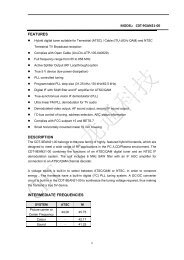
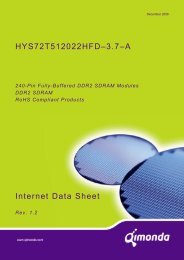

![Internet Data Sheet HY[B/I]39SC128[800/160]FE Rev. 1.1 - UBiio](https://img.yumpu.com/31629373/1/184x260/internet-data-sheet-hyb-i39sc128800-160fe-rev-11-ubiio.jpg?quality=85)
